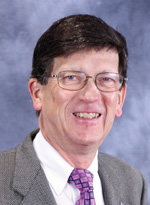
Edward Andres, Heartland Health
Almost a decade later, it’s still hard for Edward Andres to talk about it. The trauma surgeon at Heartland Health had been summoned to the hospital late at night to treat a Missouri Western State University student—gunshot wound. “Through no fault of his own,” Andres remembers. “He was an innocent person, he was paralyzed. We went through 34 units of blood in the middle of the night, then he spent three months in the hospital.” But he survived.
And last December, eight years after the shooting, the patient invited the doctor to attend his graduation from MWSU. That’s one of the things that sticks with Andres after more than 40 years as a practicing physician. That, and “the fact that the hospital, without batting an eye, spent $700,000 to take care of this kid, who fortunately for everybody, had health insurance. I think that was the crowning achievement of our system,” Andres said.
A native of Tucson, Ariz., he earned his medical degree from Baylor, and did his residency there. He took the long way to St. Joseph, passing through Nha Trang during the war in Vietnam. “I never got shot at,” he recalls, but he was close enough to battle to treat soldiers less than 15 minutes after they’d been wounded. That instilled in him an interest in trauma surgery, and he came to Missouri with that track in mind.
In 1971, there were no trauma centers, and St. Joseph didn’t yet have ambulance service. Over the years, Andres was instrumental in creating the first Level II-trauma center in the state, and spent most of his career in vascular and trauma surgery. Some years ago, he was able to deliver the happy news that a woman suspected of having breast cancer was, in fact, cancer-free.
She was glad to hear it but said getting to that diagnosis took too long. “I said, ‘You’re right; it did,” he recalls. So he started working on a process that culminated with the hospital’s breast-cancer center, a collaboration that included previous competitors in surgical practice. “Getting everybody on the same page, one that’s patient-oriented, instead of doctor-oriented, took almost five years, and it’s still a work in progress,” he said.
The work is particularly rewarding because his wife of 49 years, Grace, is a breast-cancer survivor.

T.J. Rasmussen, Orthopaedic & Sportsmedicine Consultants
T.J. Rasmussen knows all about empathy from the doctor’s perspective: An athletic injury in high school was the intersection of his own life and the skills of James Garner, the physician who took care of him. “I subsequently shadowed him on multiple occasions, including watching multiple knee operations,” Rasmussen says. “It kind of took off from there.”
And how: Today, Rasmussen is president of the medical staff at the Kansas City Orthopaedic Institute, and a staff physician at Shawnee Mission Medical Center. That puts him right at home—he’s lived in this area since his family moved in 1974, earned his undergrad degree in cellular biology at KU, then went through medical school and did both his internship and residency at the medical center. “I spent a year doing a sports and knee reconstruction fellowship with other young surgeons from all over the U.S., and I don’t think KU could have prepared me any better than they did,” he said.
He has also drawn on that sports-medicine acumen as team physician for Johnson County Community College and Bishop Miege High School, activities that combine with his love for KU sports, the region’s array of restaurants and his zest for bike-riding that balance out his work life. “My wife and I have traveled a fair amount and wouldn’t think
of living anywhere else,” he says.
That work is fulfilling, but “the biggest challenge,” he said, “is time management between seeing patients, performing surgery, making rounds and dealing with paperwork, or increasingly, computer work.”
Like most any physician who wields a scalpel, he finds rewards in the outcomes: “Orthopedics is a fairly ‘concrete’ specialty and the outcomes are usually pretty good.” And with positive results come positive interactions: “I really enjoy my patients,” Rasmussen said. “I enjoy talking to them. I enjoy helping them get better. I spend a lot of time educating patients before and after surgery so that they understand what’s wrong, what we are going to do about it, and what the realistic expectations are.”
He credits mentors like James Garner and Fred Reckling, who chaired the orthopedics program at KU, and physicians Jim Neff and Marc Asher: “They all taught me you can accomplish much more than you think or imagine you can.”